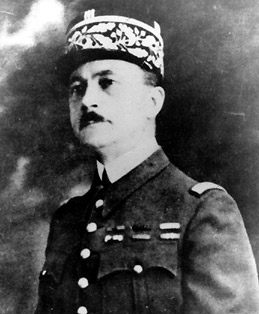Natzweiler-Struthof
 General Charles Delestraint,
a prisoner at Natzweiler
General Charles Delestraint,
a prisoner at Natzweiler
The most famous inmate at Natzweiler
was General Charles Delestraint, the leader of the Secret French
Army, shown in the photo above.
A veteran of World War I, Delestraint
was an expert on tank warfare; he commanded a mechanized French
division in World War II. In fact, Delestraint was de Gaulle's
commanding officer in World War II. After France surrendered
in June 1940, de Gaulle escaped to London where he set up a Free
French organization and directed guerrilla warfare against the
German occupation of France.
In 1942, Delestraint was recruited by
the French resistance; he secretly visited his old friend Charles
de Gaulle in London and was given the job of commanding the French
Armée Secret, which had been created on the initiative
of Jean Moulin.
On June 9, 1943, Delestraint was arrested
by the Gestapo. After being imprisoned for months in a Gestapo
prison at Fresnes, General Delestraint was sent in March 1944
to Natzweiler where he remained until the camp was evacuated
in September 1944. As soon as he arrived in the Natzweiler camp,
the general made friends with the other prisoners, always encouraging
those who were overwhelmed by despair. He always knew just what
to say to console the other prisoners who were depressed. He
could restore the confidence of others just by his look, or with
a few words. He would take charge of the vulnerable prisoners,
giving them the courage to survive. He also shared food, that
he had stolen, with the other prisoners.
General Delestraint was classified as
a Nacht und Nebel prisoner, which means that he was not allowed
any contact with the outside world. He could not receive, nor
send letters, and his family did not know what had happened to
him. He also could not work outside the camp for fear that he
might escape. As an officer, he was exempt from any heavy work.
He had to remain in the barracks alone while the other prisoners
worked.
At the suggestion of the block leader
in charge of his barrack building, Delestraint started working
clandestinely in the camp clothing warehouse. He would rejoin
the other prisoners for roll call at the end of the day, pretending
that he had stayed in the barracks all day.
When the Natzweiler camp was abandoned,
the prisoners were taken to Dachau, where Delestraint was allegedly
executed on April 19, 1945, shortly before that camp was liberated.
Emile Schwarzfeld, who had been picked
to be Delestraint's successor as the leader of the French Secret
Army in case he was captured, was also arrested by the Gestapo
and, after spending time at Fresnes, was deported to Natzweiler-Struthof,
where he died in June 1944.
Another high-ranking prisoner at Natzweiler
was General Frere, the Commander of the French Seventh Army in
World War II. On June 14, 1940, the German Army entered Paris
and General Frere withdrew without fighting, allowing the Germans
to have their triumphant victory march through the city. After
the surrender of France, General Frere became the Commander of
the ORA, the Organization of Resistance of the Army, which fought
as insurgents on the side of the Allies in the French Resistance.
He was captured and deported to Natzweiler-Struthof where he
died in the camp.
Altogether, an estimated 56,000 French
resistance fighters were deported to concentration camps such
as Buchenwald and Natzweiler, and only half of them returned
after the camps were liberated.
|